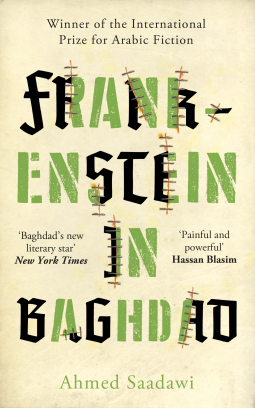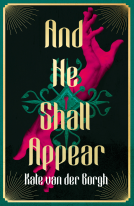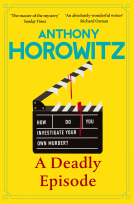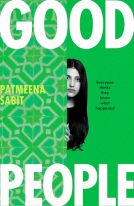
Frankenstein in Baghdad
by Ahmed Saadawi
This title was previously available on NetGalley and is now archived.
Send NetGalley books directly to your Kindle or Kindle app
1
To read on a Kindle or Kindle app, please add kindle@netgalley.com as an approved email address to receive files in your Amazon account. Click here for step-by-step instructions.
2
Also find your Kindle email address within your Amazon account, and enter it here.
Pub Date 1 Feb 2018 | Archive Date 5 Jul 2018
Oneworld Publications | Oneworld
Talking about this book? Use #FrankensteinInBaghdad #NetGalley. More hashtag tips!
Description
From the rubble-strewn streets of US-occupied Baghdad, the scavenger Hadi collects human body parts and stitches them together to create a corpse. His goal, he claims, is for the government to recognize the parts as people and give them a proper burial. But then the corpse goes missing, just as the city is hit by a wave of eerie murders, and reports start to stream in of a horrendous-looking criminal who, though shot, cannot be killed. As the violence escalates, the Whatsitsname and the havoc it wreaks assume a magnitude far greater than anyone could have imagined.
Frankenstein in Baghdad is an extraordinary achievement, at once horrific and blackly humorous, which captures the surreal reality of a city at war.
Advance Praise
'A harrowing and affecting look at the day-to-day life of war-torn Iraq.' Publishers Weekly
'A harrowing and affecting look at the day-to-day life of war-torn Iraq.' Publishers Weekly
Marketing Plan
'Outrageously adroit...this haunting novel brazenly confronts the violence visited upon this country by those who did not call it home. A startling way to teach an old lesson: an eye for an eye makes the whole world blind.' Kirkus
Available Editions
| EDITION | Paperback |
| ISBN | 9781786070609 |
| PRICE | £12.99 (GBP) |
Average rating from 12 members
Featured Reviews
This is an unexpected, surreal read as a man fashions a corpse out of the remaining body parts of victims caught up in explosions in Baghdad, and the 'Frankenstein' is then animated by a soul without a body - and is on the loose in the city.
The narrative itself feels like it's composed of many influences (like the many body parts that make up the creature): it has the feel of fables from One Thousand and One Nights, mixed with the tragic absurdity of Catch-22, and the eponymous Frankenstein.
Via this vehicle, we experience something of the real lives of Baghdad's inhabitants, mixing reality with something more fanciful. I enjoyed this but kept feeling that I was missing something - 3.5 stars.
What drew me to this novel was the intriguing title. When I think of Frankenstein I am immediately drawn to the depiction of this "monster" in the writing of Mary Shelley. Was this grotesque creature someone who attracted our sympathy or loathing; the answer is probably both. Frankenstein in Baghdad gives a modern twist to the story taking place in a war ravaged community. Hadi is a scavenger who makes a living by collecting junk and resalable items from the US occupied streets of Bagdad. This rather oddball figure also acquires human body parts and by stitching them together creates his own freak referred to as Whatsitsname, who has also inherited the soul of Hasib Mohamed Jaafar a dead security guard at the Novotel Hotel..."Because I'm made up of body parts of people from diverse backgrounds-ethnicities, tribes, races and social classes.".....The purpose of this creation and the heart of "Frankenstein in Baghdad" is to showcase war as a futile exercise where the greed and ambition of a few adds to the misery, desolation and despair of the masses..."to bring about justice in this world which has been totally ravaged by greed, ambition, megalomania, and insatiable bloodlust."
The novel is told through the eyes of a number of Baghdad residents in particular Elishva an elderly widow, in mourning for her son Daniel, who believes that Whatsitsname is his reincarnation, Mahmoud al-Sawadi a young ambitious journalist and Brigadier Majid head of the Tracking and Pursuit Department. It is a story that brought alive the smells and constant danger of a city and community at war and the inevitable casualties and heartache that an innocent population must inevitably pay. Many thanks to the good people at netgalley for a gratis copy in exchange for an honest review and that is what I have written.
 Joseph C, Reviewer
Joseph C, Reviewer
Baghdad, a city torn apart by conflict, where car bombs sow death on a numbingly regular basis. Baghdad, a city where the balance between different cultures and faiths, delicate at the best of times, is jeopardised by covert lobbies and political pressure groups. Baghdad, a city whose sons and daughters are sacrificed – lost or dead in wars, or emigrants in foreign countries, lured by the promise of peace.
These daily horrors are transformed by Ahmed Saadawi into a contemporary Gothic novel, in which the violence which stalks the streets of Baghdad is personified in the figure of the monstrous “Whatsisname”. Pieced together by Hadi the Junk Dealer from body parts of car bomb victims, the Whatsisname is animated by the soul of Hasib Mohamed Jaafar, a hotel guard killed in a terrorist attack. The spark which joins body and soul is the constant prayer of old Elishva, who has not yet lost hope of the return of her son Daniel, lost decades before in the Iran-Iraq War. The “Whatsitsname” embarks on a mission of righteous revenge against criminals, only to become himself (itself?) drawn into a vicious cycle of violence.
Frankenstein in Baghdad won its author the International Prize for Arabic Fiction in 2014 and is now available in a brilliant English translation by Jonathan Wright. It was suggested to me by a friend as a work of “Iraqi Gothic” – and “Gothic” it certainly is. After all, it features a monster nicknamed by the Baghdadi newspapers as “Frankenstein”, it contains brief but stomach-churning passages of body horror and it recycles and adapts several tropes of the genre – the ruins of old replaced by bombed-out buildings, the cemeteries replaced by the tragic scenes following the umpteenth terrorist attack. There is also more than a nod to the Gothic in the fragmented narrative and the recurring theme of mistaken identities. Thus, the book opens with a “Final Report” about the shadowy “Tracking and Pursuit Department” which casts doubt on the veracity of the whole story presented to us. Part of the novel is a transcript of an interview recorded by the monster himself or, possibly, an impostor posing as him. Throughout, there is a sense that “nothing is but what is not”.
Yet, particularly in its initial chapters, what the novel reminded me of were not the classics of the Gothic but, rather, the works of Mikhail Bulgakov. In fact, as in Bulgakov, the fantastical elements often have a whimsical, surreal, fairy-tale tinge quite unlike traditional “supernatural” fiction – saints speak from icons, astrologers assist the army, the souls of the dead meet for chats. There is also a strong streak of dark humour and satire which sometimes had me laughing aloud. Admittedly, the novel becomes increasingly grim as it progresses and the final scene is poignant, bleak and very effective.
It was recently announced that the novel would be turned into a film. I certainly look forward to that. This unusual and striking novel certainly deserves to be well-known.
 Neil G, Reviewer
Neil G, Reviewer
Frankenstein in Baghdad was originally published in Arabic in 2013. In 2014, it was awarded the International Prize for Arabic Fiction (sometimes known as the “Arabic Booker”). It is now (early-2018) being made available in English translation (by Jonathan Wright). Writing in the New York Times in 2014, Tim Arango said ”Mr. Saadawi … is at the vanguard of a small group of writers starting to interpret, through fiction, the trauma wrought from the American invasion of 2003.”. And you can judge how important this book is for the Iraqi people from the fact that the article goes on to quote another Iraqi author (Ibrahim Abdul Jabbar) as saying about Saadawi, and this book in particular, that ”He has given us faith that Iraq is still alive, and we are the ones who can make change if we have the will.”
In fact, the whole article by Arango is worth reading: "https://www.nytimes.com/2014/05/17/world/middleeast/iraqi-novelist-dodging-bombs-writes-to-clear-the-fog-of-war.html"
Framed as a story developed from documents sent to “the author” by a source within the Tracking and Pursuit Department, Frankenstein in Baghdad tells the story a monster on the loose in Baghdad. It is magical realism. It is gothic horror. It is an exploration of the damage done to property, culture and people by the war.
I was staggered to discover this Wikipedia page when doing some background research. The book is set in 2005 (the year of the first free elections after the fall of Hussein) and this page lists the acts of terror in Iraq during that year: "https://en.wikipedia.org/wiki/Terrorist_incidents_in_Iraq_in_2005". It is a sobering read and the book itself is punctuated by ongoing acts of terror (suicide bombings). We learn a bit of what it is to live in a city scarred by war and its consequences. For an outsider (e.g. me) this is harrowing reading, but it is impossible not to pause and imagine what it must be like for the actual inhabitants of the city and what it must be like to read this book if you have been part of the story it tells.
The book begins with a suicide bombing:
”The explosion was horrific—and here Hadi looked to Aziz for confirmation. Hadi had run out of the coffee shop. He had been eating some of the beans that Ali al-Sayed made in the shop next door and that Hadi ate for breakfast every morning. On his way out of the shop he collided with people running from the explosion. The smell suddenly hit his nostrils—the smoke, the burning of plastic and seat cushions, the roasting of human flesh. You wouldn’t have smelled anything like it in your life and would never forget it.”
And this sets the tone for the book where everyday actions of living in the city (coffee, breakfast, etc.) are mingled with acts of terror and gore. In fact, in one of life’s unpleasant coincidences, the day I wrote this review (15 Jan 2018) was marked by a huge suicide bombing in the same city square as the one that opens this book, making the message of this book all the more important and contemporary.
Near the start of the book, we meet Hadi who has assembled a corpse from body parts he has gathered in the aftermath of the multiple suicide bombings that are destroying Baghdad. By a bizarre series of events, that corpse is animated and becomes the Frankenstein-type of the book’s title. The creature becomes a metaphor for the war that has wreaked havoc in Baghdad. Initially, the Whatsitsname (the label given to the creature) sets out to kill the people responsible for the deaths of those who make up his body. But, like war, it does not stop there:
”There’s no harm in warning him so he doesn’t offend me again. I’m now taking revenge on people who insult me, not just on those who did violence to those whose body parts I’m made of,” the Whatsitsname said.
The killing gets out of control, mirroring the impact and destructive patterns of war in the city.
The book is all the more chilling for the sparsity of its prose. Saadawi does not mess around with words, but he does notice some macabre details that bring home the reality of life in a war torn city:
"In the coffin they put his burned black shoes; his shredded, bloodstained clothes; and small charred parts of his body.”
And, in parallel with the story of the Whatsitsname, we see other stories of people in Baghdad as they develop and interact. It is worthwhile spending some time on the character list at the start of the book as this makes the story easier to follow, especially for Western readers who will find some of the names hard to remember. Don’t be fooled by the title: this is not just a horror story about a monster. It is about people, it is about life in Iraq, it is about the consequences of war.
This has all the feel of a very important book. Important primarily for the people it is about and who must be its primary target. But also important for the rest of the world, which makes its English translation a significant event. As Arango says in his review:
”For the Americans, though, turning their experiences into fiction is a retrospective act, because their war ended. For Iraqis like Mr. Saadawi, the war is still their present, haunting their reality even as they try to make the best of it — going to work in the morning, putting dinner on the table, watering the plants.”
Like me, you may not read many books that concentrate on magical realism, allegory and symbolism. But you should read this one.
 Paromjit H, Reviewer
Paromjit H, Reviewer
This is a novel that depicts the horror, chaos, and mass death that has visited the residents of Baghdad in Iraq since the US occupation, delivered with the blackest of humour via the reinterpretation of the Gothic Frankenstein. The only constant is the rising tide of the dead and missing, with many friends and family unable to access a body, sometimes the odd pieces of body parts but there is no guarantee. There were times that this story felt like a piece of Cubist art, with a disjointed picture representing different aspects of life and death in this most ill-fated of cities. We follow a cast of characters, the elderly Elishva lives in her coveted home with her cat, she lost her son, Daniel in the Iran-Iraq War, her 2 daughters live in Melbourne, and a crooked realtor is determined to acquire her home. Elishva has never gotten over the loss of Daniel and yearns for his return. Hadi, a junk dealer loses his beloved business partner, with no body he collects various body parts that represent every part of the Iraqi community and stitches together a composite corpse. This corpse becomes inhabited by a soul of a dead guard in search of a body. So Frankenstein, or Whatsitsname as he is referred to, is born.
Elishva claims him as Daniel, her son, returning as promised by St George. The neighbourhood think with so many missing and dead, some are bound to return like Daniel. Whatsitsname seeks vengeance for all those who make up his body. Sought by the Americans, the Iraqi military, and Brigadier Majid of the Tracking Unit, discover this is a criminal who is bullet proof and cannot be killed. A number of parties lay claim to and support Whatsitsname, seeing him as representing all Iraqis who have suffered under the US and various corrupt and murderous Iraqi sectors, or as God or whatever fits their particular perspective. Mahmoud, a journalist, tries to get the bottom of the rumours surrounding Frankenstein, interviewing Hadi, eventually getting hold of recordings of Whatsitsname explaining his purpose. Whatsitsname keeps losing body parts as he achieves vengeance for that person, at first, those parts are replaced by innocent victims although soon any parts will do, even those of the guilty. There is a philosophical discussion as to whether such a demarcation of innocent and guilty can truly exist as Civil War erupts.
Saadawi has written an intelligent satire on the sorrow and grief that is Iraq, and Baghdad in particular. I appreciate his approach, because quite honestly it would otherwise be unbearable and grim to read about It is inevitable that amidst the never ending explosives, car bombs, al-Qaeda, US actions, religious factions that mental health issues would proliferate amidst the never ending loss and grief experienced by local Iraqis. I love the inclusion of the magicians, djinns, astrologers who play a vital role in political and military decision-making. The horror continues in the Iraq of today with continuing use of car bombs, the presence of religious factions and more. This is an extraordinary glimpse of some of what ordinary Iraqi citizens have experienced in recent times, that is if they are still alive. I hope many will choose to read this brilliant and compelling novel, it deserves much wider recognition. Many thanks to Oneworld Publications.


















